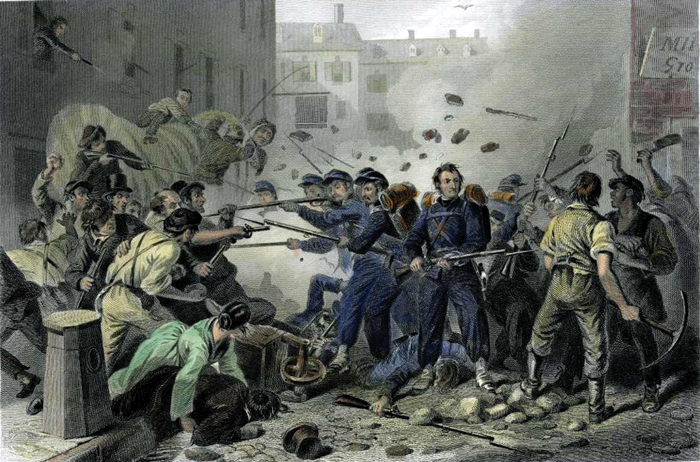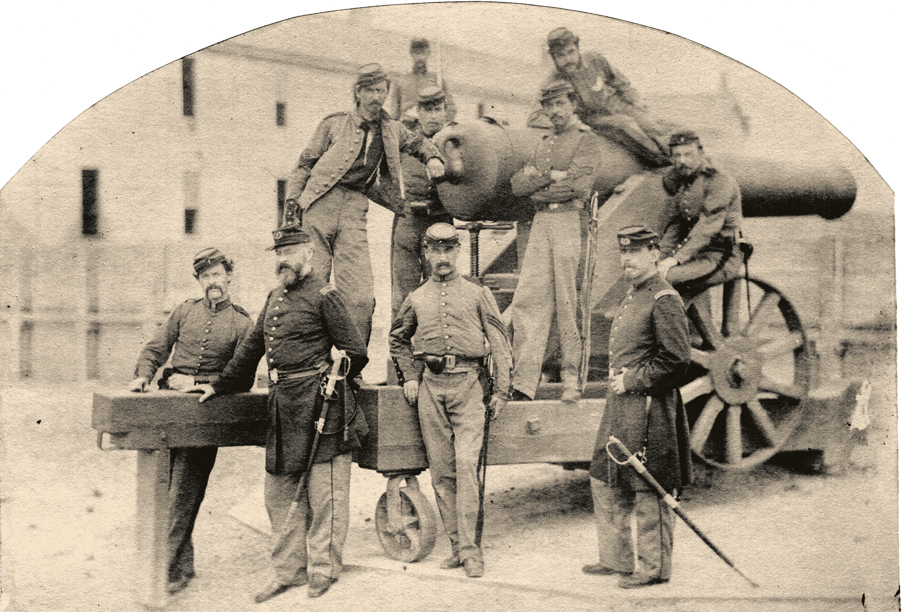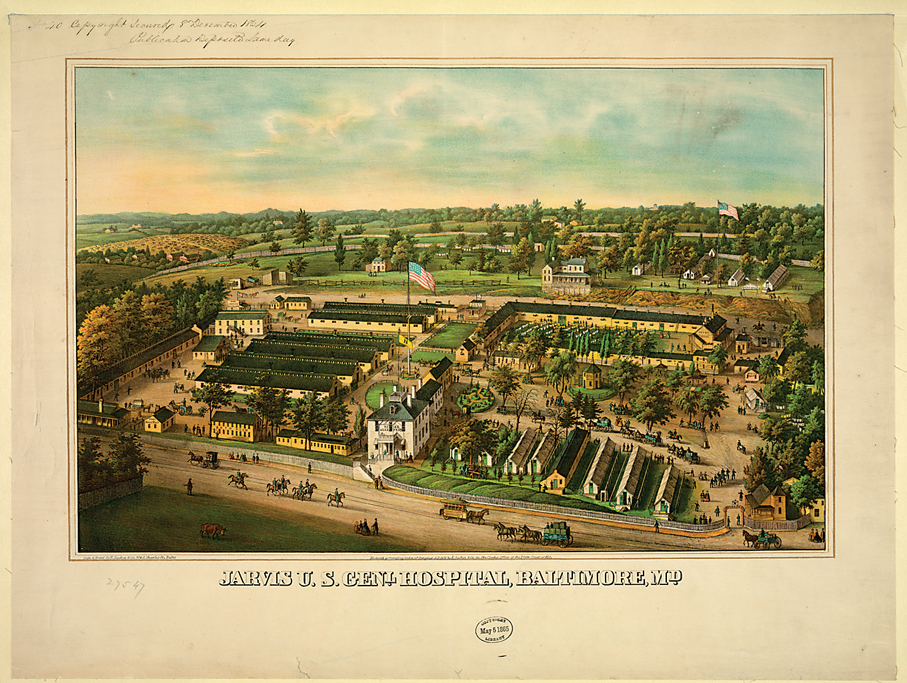History & Politics
Where The Civil War Began
How the Pratt Street Riot determined the course of the war.

On the morning of April 19, 1861, the 6th Massachusetts Infantry arrived at Baltimore’s President Street Station on its way to defend the nation’s capitol in Washington City. Seven days earlier, South Carolina forces had fired on Fort Sumter, moving President Lincoln to call for 75,000 volunteers to suppress the rebellion. The soldiers aboard the train, which had left Boston two days earlier, formed the first fully armed regiment to volunteer.
Despite the fact that three different railroads had terminals in Baltimore at the time, there was no through service—a city ordinance prohibited locomotives from passing through the city. Each car had to be uncoupled from the inbound train and pulled by horses down President Street and along the waterfront on Pratt Street to Howard where it was attached to a B&O locomotive at Camden Station for the final stage of its journey to Washington City.
Baltimore had a reputation as a rough town with a lot of sympathy for Southern interests. It was considered such hostile territory for Lincoln that the President had carefully avoided riding through it during daylight hours en route to his inauguration a year before.
As each car carrying the 6th Massachusetts Infantry rolled along Pratt Street, one by one, the citizens of Baltimore became more and more agitated at the spectacle of Northern troops passing through their city to make war on the recently seceded states. A crowd of pro-Southern activists, street gangs from the waterfront, and spectators began to pack both sides of Pratt Street. With names like American Rattlers, Blood Tubs, and Pug Uglies, the gang members were a brutal reminder of Baltimore’s pre-war nickname, “Mob Town.” Yelling at the soldiers soon escalated to the throwing of rocks and bottles.
Finally, gunshots rang out.
Six companies managed to run the gauntlet, but when Company K’s horse-drawn car turned onto Pratt Street, a large anchor was thrown into its path, causing a derailment. While Major Benjamin F. Watson bravely jumped to the ground and tried to get the wheels back on track, the mob focused its anger on the stranded soldiers.
“They were insulting and noisy, and threw at the car bricks, pieces of iron and coal, and…the vilest epithets they could invent for us,” one soldier in the regiment later wrote.
When one of the men had his thumb shot off, the order was given to return fire. Company K abandoned the passenger car just short of Howard Street and marched through the mob to Camden Station, taking their wounded with them. The four companies stranded at President Street Station marched along the railroad tracks in an effort to join the rest of the regiment, and were likewise pelted with paving stones and other objects as well as a deadly spray of gunfire.
George W. Booth, a future member of the First Maryland Infantry CSA—one of six battalions of the Confederate Army made up of Marylanders—described what he observed from the corner of Pratt and Commerce Streets. “A soldier, struck by a stone, fell almost at my feet, and as he fell, dropped his musket, which was immediately seized by a citizen, who raised it to his shoulder and fired into the column,” he wrote. “The rear files faced about and delivered a volley into the crowd, who responded with pistol shots, stones, clubs, and other missiles. A perfect fusillade was kept up between the troops and the enraged mob.”
By the time the last company reached the safety of Camden Station, four soldiers were dead and 36 wounded. At least a dozen civilians were known to have been killed. It was this stirring event that motivated James Ryder Randall to write the poem My Maryland that was later put to music under the title Maryland My Maryland and printed in Baltimore. Banned by federal authorities, it became one of the most popular Southern songs of the war.
In the aftermath of the riot, a mass meeting was held at Monument Square on Calvert Street. Governor Thomas Holliday Hicks addressed the immense crowd of more than a 1,000 that surrounded the War of 1812 monument dedicated to the “Old Defenders” of Fort McHenry and North Point. It was the symbol of the city then as it is today.
“I am a Marylander,” he told them. “I love my state and I love the Union, but I will suffer my right arm to be torn from my body before I will raise it to strike a sister state.”
The clash on the streets of Baltimore that day is considered the first land battle of the Civil War and it would forever after be known as “The Pratt Street Riot.” What happened in Baltimore during the next 30 days would in no small way determine the course of events for Maryland and the nation during the four years of the Civil War.

To appreciate Baltimore’s history, one must understand its geography. For one, there is the obvious advantage of being near the center of the East Coast, with a good harbor 160 miles inland from the Atlantic Ocean. Also, nestled against the fall line of the Blue Ridge Mountains where the abrupt drop in elevation produces fast-moving bodies of water, it had the Patapsco River and the Jones Falls to provide power to its mills and factories when the Industrial Revolution began. Finally, it had the Baltimore & Ohio Railroad that connected the Ohio Valley with the docks of Baltimore. By 1860, this marriage of industry and transportation combined to make Baltimore the third largest city in the United States and the largest industrial city in the South.
During the presidential election of 1860, the National Democratic Party held no less than three separate conventions in Baltimore City. Each produced its own candidate for president. The divisiveness of the Democrats virtually gave the election to the Republican Party, which had been founded by Northern anti-slavery activists just six years earlier. Republican nominee Abraham Lincoln was far from popular in Maryland, receiving fewer than 2,300 votes statewide.
But, as a border state, Maryland would not rush to join the deep-south states in a secessionist movement. In fact, Baltimore could best be described as a city with a Southern personality and a Northern economy. The Carrolls and Howards and other Old Line families of Revolutionary War fame had their slaves and country estates, but the railroads ran north and west, and that is where most of the business was done.
Added to this was the hyper-immigration from Ireland and Germany during the previous two decades that changed the political landscape of the city by 1861. While the longtime affluent residents of the city lived in an economic fortress around Mt. Vernon Square, newly arrived immigrants flooded the voting wards of the lower class. Generally speaking, the Germans settled on the east side of the city and were somewhat divided over the secession issue. The Irish tended to congregate on the west side around the facilities of the Baltimore & Ohio Railroad where unskilled labor was in constant demand. The anathema of the slave-owning class, they would give little support to the secession movement.
In the wake of Fort Sumter, when Lincoln called for troops to head south to put down the rebellion, Virginia, an upper South holdout, responded by passing an act of secession. Now all eyes were on Maryland, the only Southern state located north of Washington City. If Maryland seceded from the Union, the nation’s capital would be located behind enemy lines. Even worse, the only direct rail link between Washington and the North was through Baltimore.
On the day of the Pratt Street Riot, with the dead and wounded still lying on the streets of Baltimore, Mayor George W. Brown and Governor Hicks met to determine a course of action for the city. For the time being, they would side with the rioters.
To prevent further movement of troops through Baltimore, they ordered John Merryman, a lieutenant in the Baltimore County Horse Guards, to burn railroad bridges north of the city. In Mayor Brown’s post-war account of this eventful day, he wrote that the condition of the city “ . . . may best be described as one of armed neutrality.”
The only remaining symbol of federal authority was the U.S. flag flying over Fort McHenry. Staffed by the U.S. Army, the fort now turned its guns to face the city it had been built to defend. Tensions between the soldiers there and the citizens of Baltimore could not be higher.
On the day after the Riot, Baltimore police commissioner John W. Davis met with the commanding officer at Fort McHenry, Captain John C. Robinson. Davis warned the captain of a rumored attack on the fort that night and offered the services of 200 men from the Maryland Guard Battalion as an addition to his defense force. Knowing the pro-Southern leaning of many of its members, Robinson declined the offer with a warning that if any of the guardsmen passed the Catholic chapel on Fort Avenue he would open fire with his cannons.
Commissioner Davis responded to the threat with one of his own: “If you do that, and if a woman or child is killed, there will be nothing left of you but your brass buttons to tell who you were.”
Maryland teetered on the brink of secession and President Lincoln’s worst nightmare had come true. All direct contact between the loyal states and their capital had been severed.
But the battle for Baltimore wasn’t over.
Traveling one day behind the 6th Regiment was a general from Massachusetts named Benjamin F. Butler with another regiment of Bay State volunteers. In a clockwise motion, he moved from the Susquehanna River to Annapolis, where he reopened rail communications between that city and Washington on April 24. Eleven days later, he occupied Relay Station, just west of Baltimore on the main line of the B&O, thus securing the entire length of its Washington Branch.
On May 13, Butler secretly moved troops by rail from Relay to Baltimore. Arriving near sundown at Camden Station, he marched his men to Federal Hill and dug in. The next day the citizens of Baltimore awoke to find the American Flag flying on Federal Hill and artillery guarded by the same regiment they attacked on April 19, the 6th Massachusetts.
This ended all overt opposition to the movement of troops and supplies between Washington and the North. More importantly, assets of the largest industrial city in the South would be used to supply the Union army. However, despite a strong military presence in the city, a Confederate underground flourished until the very end of the war.

Life in Baltimore changed dramatically after Union troops secured the city. The Middle Military Department was created to control Maryland during the war with a major general headquartered in the city. The Writ of Habeas Corpuswas suspended and the U.S. Army made wholesale arrests of Southern sympathizers.
By the end of 1861, 112 civilians had been arrested and imprisoned at Fort McHenry. By the end of the war, it was more than 2,000. Most notable of these was the grandson of Francis Scott Key, the author of “The Star-Spangled Banner.”
Baltimore rapidly took on a war-like appearance. Carroll Park on the west side of town became the site of the largest Union encampment in the city. From here, the First Maryland Infantry Regiment left for Union field service in 1861. Throughout the war, units from other states were stationed there to train and guard the nearby B&O repair shops at Mount Clare. By 1864, more than 40 camps and forts had been erected to protect the city and train new recruits for the Union Army.
In September of 1862, the bloodiest day of the war was fought along the Antietam Creek in Western Maryland. In its aftermath, trainloads of wounded soldiers arrived at the B&O’s Camden Station. Prisoners were processed at Fort McHenry and a number of buildings throughout the city were converted for hospital use, including Newton University on Lexington Street. In 1863, a 1,200-bed hospital was opened in Patterson Park. These hospitals had a remarkable success rate. In 1864, the Patterson Park Hospital treated 6,459 patients, with only 45 deaths recorded.
After three brutal days of fighting at Gettysburg July 1-3, 1863, trainloads of wounded soldiers arrived badly in need of medical attention, disrupting Fourth of July activities in the city. The Western Maryland Railroad also delivered thousands of Confederate prisoners. Later, trains brought the bodies of men whose families could afford the cost of shipping them home for burial. The most notable of these was General Lewis A. Armistead, who had been mortally wounded in Pickett’s Charge. He was buried in St. Paul’s Cemetery next to his uncle, Colonel George Armistead, who had commanded Fort McHenry during the War of 1812.
Four months after the Battle of Gettysburg—the bloodiest of the war, with more than 50,000 casualties on both sides, and widely considered its turning point—a national cemetery was dedicated there to honor the Union dead. President Lincoln passed through Baltimore on November 18 en route to deliver his now immortal Gettysburg Address. Arriving on a special B&O train at Camden Station, he was escorted to the Northern Central’s Bolton Station by eight companies of the Fifth New York Heavy Artillery.
The undercurrent of Southern support in the city continued throughout the war and led to many arrests. Social organizations and newspapers felt the hand of federal authority too. In 1863, General Schenck ordered the Maryland Club, then located at the corner of Cathedral and Franklin Streets, closed, declaring it “a resort for those disaffected toward the government.” In November of 1864, General Wallace had the idle club converted into a reception center for recently freed slaves and renamed “Freeman’s Rest.”
The year 1865 saw a rapid disintegration of the Confederacy. In the North, the celebrations that followed Lee’s surrender at Appomattox Courthouse were stilled by news of Lincoln’s assassination.
Maryland, the little state that had caused Lincoln so much trouble in 1861, would literally be the death of him in 1865. All but one of the assassins were Marylanders and many had ties to Baltimore. John Wilkes Booth had often performed in the Baltimore theaters. He met two of the conspirators, Samuel Arnold and Michael O’Laughlen, at Barnum’s Hotel on Calvert and Fayette Streets in August of 1864.
The last great event in Baltimore’s Civil War history was the passage of Lincoln’s funeral train through the city on April 21, 1865. Lincoln’s body laid in state at the Capitol building for two days after his official funeral, which, coincidentally, fell on April 19, the anniversary of the Pratt Street Riot. Then it was placed in his private railcar for the sad journey back to Springfield, IL.
The route would be a reversal of his 1861 inaugural trip. During that trip, Lincoln passed through the city under the cover of darkness, fearing an assassination plot. Now there was no danger. Leaving from the B&O’s Washington Depot, the 10-car train arrived at Camden Station at 10 a.m. His casket was off-loaded into a hearse pulled by four white horses. The funeral procession took three hours as it wound its way through a pouring rain to the Merchant’s Exchange on Market Street, where an estimated 10,000 people viewed the body. At 2 p.m., the coffin was closed and taken to the Bolton Street Station. There a Northern Central locomotive waited to pull the funeral train to Harrisburg, PA, where the sad ritual would be repeated.
Perhaps no event since the British attack on Fort McHenry in 1814 had more of an effect on Baltimore than the Pratt Street Riot. It made the city the first front of the Civil War. The handful of casualties that occurred on that day would not compare to Antietam or Gettysburg, but they were not insignificant. They brought the war much closer to home for the Northern states than the firing on Fort Sumter and helped them mobilize in defense of the Union. Butler’s fortifying of Federal Hill in 1861 transferred the opening battle lines of the Civil War in the east from the Susquehanna River to the Potomac. The road to Richmond would begin in Maryland, not go through it.